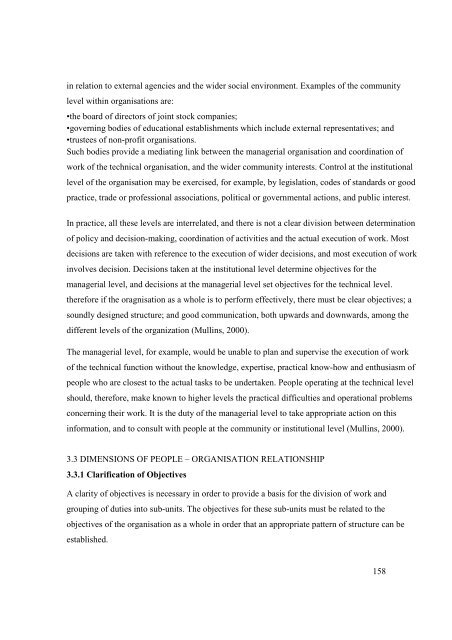HCM 433 MANGEMENT AND ORGANIZATIONAL BEHAVIOUR.pdf
HCM 433 MANGEMENT AND ORGANIZATIONAL BEHAVIOUR.pdf
HCM 433 MANGEMENT AND ORGANIZATIONAL BEHAVIOUR.pdf
Create successful ePaper yourself
Turn your PDF publications into a flip-book with our unique Google optimized e-Paper software.
in relation to external agencies and the wider social environment. Examples of the community<br />
level within organisations are:<br />
•the board of directors of joint stock companies;<br />
•governing bodies of educational establishments which include external representatives; and<br />
•trustees of non-profit organisations.<br />
Such bodies provide a mediating link between the managerial organisation and coordination of<br />
work of the technical organisation, and the wider community interests. Control at the institutional<br />
level of the organisation may be exercised, for example, by legislation, codes of standards or good<br />
practice, trade or professional associations, political or governmental actions, and public interest.<br />
In practice, all these levels are interrelated, and there is not a clear division between determination<br />
of policy and decision-making, coordination of activities and the actual execution of work. Most<br />
decisions are taken with reference to the execution of wider decisions, and most execution of work<br />
involves decision. Decisions taken at the institutional level determine objectives for the<br />
managerial level, and decisions at the managerial level set objectives for the technical level.<br />
therefore if the oragnisation as a whole is to perform effectively, there must be clear objectives; a<br />
soundly designed structure; and good communication, both upwards and downwards, among the<br />
different levels of the organization (Mullins, 2000).<br />
The managerial level, for example, would be unable to plan and supervise the execution of work<br />
of the technical function without the knowledge, expertise, practical know-how and enthusiasm of<br />
people who are closest to the actual tasks to be undertaken. People operating at the technical level<br />
should, therefore, make known to higher levels the practical difficulties and operational problems<br />
concerning their work. It is the duty of the managerial level to take appropriate action on this<br />
information, and to consult with people at the community or institutional level (Mullins, 2000).<br />
3.3 DIMENSIONS OF PEOPLE – ORGANISATION RELATIONSHIP<br />
3.3.1 Clarification of Objectives<br />
A clarity of objectives is necessary in order to provide a basis for the division of work and<br />
grouping of duties into sub-units. The objectives for these sub-units must be related to the<br />
objectives of the organisation as a whole in order that an appropriate pattern of structure can be<br />
established.<br />
158
















